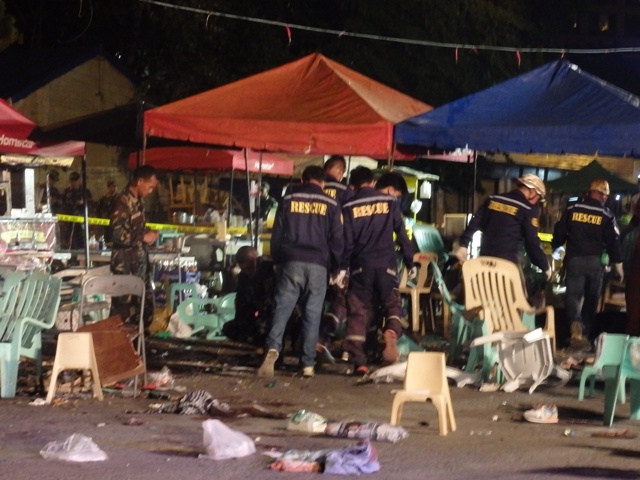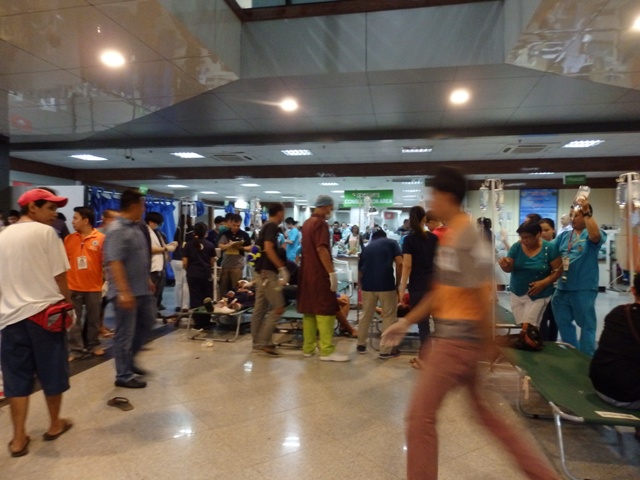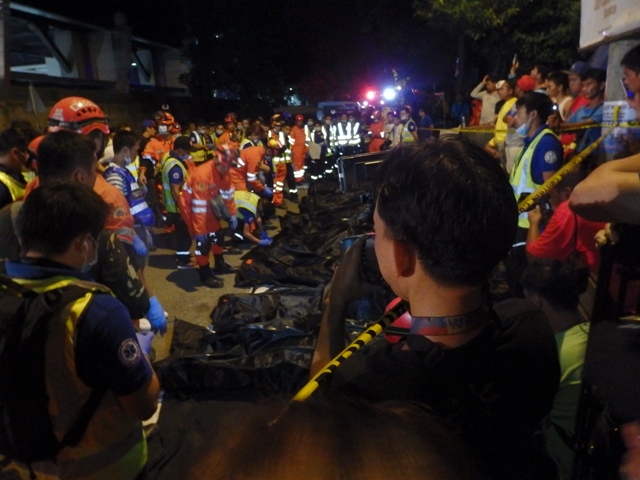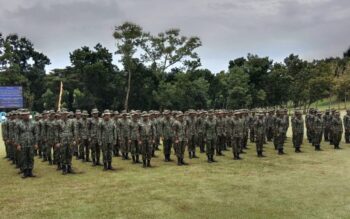DAVAO CITY (MindaNews / 03 September) – Fourteen persons, including a 12-year old boy, were killed, three of them expiring at the hospital, while 71 others were injured in an explosion at the popular night market along Roxas Avenue here at around 9:50 p.m. Friday.
Six hours later, while visiting the blast site, President Rodrigo Duterte declared a “state of lawlessness” nationwide “until there is a threat against the people and nation.”
 ONE BLAST, 13 KILLED. In the aftermath of the explosion at the night market along Roxas Avenue at around 9:50 p.m. Friday, 02 September 2016: Ten dead. Three more expired at the hospital as of 2 a.m. Sixty three others were rushed to five hospitals for treatment of injuries, a number of them in critical condition. MindaNews photo by Carolyn O. Arguillas
ONE BLAST, 13 KILLED. In the aftermath of the explosion at the night market along Roxas Avenue at around 9:50 p.m. Friday, 02 September 2016: Ten dead. Three more expired at the hospital as of 2 a.m. Sixty three others were rushed to five hospitals for treatment of injuries, a number of them in critical condition. MindaNews photo by Carolyn O. Arguillas
He clarified he was not declaring martial law, and that this has nothing to do with the suspension of the writ of habeas corpus but he will ask the Armed Forces of the Philippines and the Philippine National Police “to run the country according to my specifications.”
“There will be a lockdown in the city and there will so many checkpoints along the way. These are extraordinary times and I suppose I am authorized to allow the security forces of our country to do searches” at checkpoints, among others.
“I have this duty to protect the country, I have this duty to keep intact the integrity of our nation,” he said.
Addressing Davao City residents, the President, who served as city mayor for 22 years across seven terms, said: “Be calm,” the President said, adding the bombing is “seasonal in our city.”
“This is not the first time that Davao City has been sacrificed at the altar of violence,” he said.
Blast from the past: 13 years ago
Friday night’s blast was the first in the city after 13 years, and the first since Duterte became the President.
In 2003, when Duterte was on his fourth term as city mayor, two bombings struck the city a month apart, killing a total of 38 and injuring 200.
Twenty-two persons were killed and 155 others at the waiting shed of the old airport on March 4. A month later, on April 2, another bomb exploded at the seaport, killing 16 and injuring 45 others.
Then President Gloria Macapagal-Arroyo declared a state of lawless violence on April 3, a day after the second bombing, but the coverage was not nationwide, but only Regions 11 and 12.
General Order NO. 3 directed the AFP and the PNP “to prevent and suppress acts of terrorism and lawless violence in Regions 11 (Southern Mindanao) and 12 (Central Mindanao) and to carry out actions and measures to implement the order with due regard to the constitutional rights of every individual.”
In Friday night’s blast, 10 persons died at the blast site while 66 others were rushed to five hospitals, most of them (34) at the Southern Philippines Medical Center (SPMC)., three of whom died. Twenty-six were brought to the San Pedro Hospital, four in Davao Doctors, and one each in Limso and Brokenshire, for treatment of injuries, a number of them in “very critical” condition.
Dr. Leopoldo Vega, SPMC director told reporters shortly before 1 a.m. Saturday that 31 victims (the figure was later updated to 34) were rushed to the hospital, two of whom expired while being resuscitated, while seven were rushed to the operating rooms, one of whom later expired.
 At the emergency room of the Southern Philippines Medical Center at around 11:30 p.m. Friday, when the critically injured had been rushed to the operating rooms. Thirty four victims were rushed to the state-run hospital, three of them expired as of 2 a.m. Saturday. MIndaNews photo by Carolyn O. Arguillas.
At the emergency room of the Southern Philippines Medical Center at around 11:30 p.m. Friday, when the critically injured had been rushed to the operating rooms. Thirty four victims were rushed to the state-run hospital, three of them expired as of 2 a.m. Saturday. MIndaNews photo by Carolyn O. Arguillas.
Asked how this compares with the 2003 bombings, Vega replied, “it’s almost the same if I can remember because I was also in the emergency room at that time. The magnitude of the number of injuries was also the same. I think in 2003 we also saw 20 plus patients.”
But Friday night’s blast is incomparable to the April 1981 bombing at the San Pedro Cathedral, Vega said. “That was worst. That was different. We did operations for roughly two days,” he recalled, as two grenades exploded inside the church on that Easter Sunday.
San Pedro Cathedral was again bombed 12 years later, on December 26, 1993, killing seven and injuring at least 150 others.
The 1981, 1993, March and April 2003 bombings remain unsolved.
Still investigating
Senior Insp. Catherine dela Rey, spokesperson of the Davao City Police Office (DCPO), said they have yet to confirm what caused the explosion as they are still investigating the incident.
But Vice Mayor Paolo Duterte, who arrived at scene at 12:03 a.m. Saturday, said they are suspecting the blast may have been caused by an LPG tank explosion.
 Ten of the 14 victims killed in Friday night’s blast in Davao City did not make it to the hospitals. They died at Ground Zero of the night market and were later placed in body bags on one side of Padre Zamora St., just a few meters from the blast site. MindaNews photo by Carolyn O. Arguillas
Ten of the 14 victims killed in Friday night’s blast in Davao City did not make it to the hospitals. They died at Ground Zero of the night market and were later placed in body bags on one side of Padre Zamora St., just a few meters from the blast site. MindaNews photo by Carolyn O. Arguillas
Ten of the 14 victims killed in Friday night’s blast didn’t make it to the hospital. They died at Ground Zero along Roxas Avenue in Davao City. They were placed in body bags and laid on one side of Padre Zamora St., just a few meters from the blast site. MindaNews photo by Carolyn O. Arguillas
Ten of the 14 victims killed in Friday night’s blast didn’t make it to the hospital. They died at Ground Zero along Roxas Avenue in Davao City. They were placed in body bags and laid on one side of Padre Zamora St., just a few meters from the blast site. MindaNews photo by Carolyn O. Arguillas
President Duterte refered to it as “bombing.”
The vice mayor said that of the 10 who were killed on impact, five were men and five were women.
The Roxas night market was opened in 2013 and was closed for a weeks last month.
“The ground shook”
The bomb exploded on the street between the compound of the Christ for All Nations Church and the Ateneo de Davao University’s Community Center Building.
ADDU security guard Benedicto Torres said he felt the ground shake because of the loud explosion.
The victims were immediately taken to the entrance of the Community Center Building by the Central 911 responders. The dead were placed on one side of Padre Zamora Street.
Torres said that after the blast, he saw a smoke that wafted above the tents where the massage therapists were.
A still undetermined number of masseurs were injured, among them the pregnant Vicenta Asperin, 21, who is on her sixth month going on seventh, according to her elder sister, Dahlia. She said it will be Vicenta’s first baby.
Torres said several night market-goers, most especially students of the university, scampered to to the Community Center Building for safety. (Carolyn O. Arguillas and Antonio L. Colina IV / MindaNews)
